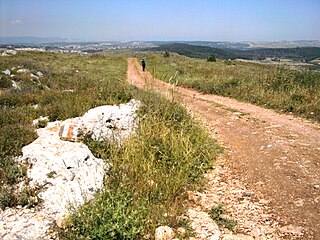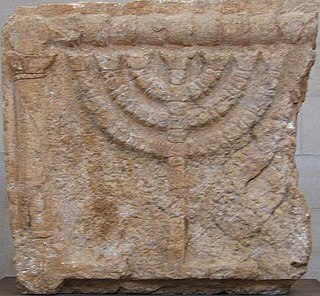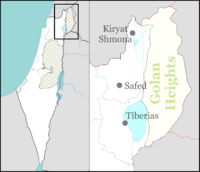
Kafr ʿInān, was a Palestinian Arab village in the Acre Subdistrict around 33 kilometres (21 mi) east of Acre. Until 1949, it was an Arab village built over the ruins of ancient Kefar Hanania. Archaeological surveys indicate Kefar Hanania was founded in the Early Roman period, and was inhabited through the Byzantine period. It was resettled in the Middle Ages and the modern era.

Marus was a Palestinian village in Upper Galilee, 7 km northeast of Safad. In the Roman and medieval period it had Jewish population, and by the 16th century it became entirely Muslim. After a period of desertion, it was resettled by Algerian Arabs. It was depopulated in 1948 during the Operation Hiram by the Israeli attacking brigade Sheva' Brigade.

Capernaum was a fishing village established during the time of the Hasmoneans, located on the northern shore of the Sea of Galilee. It had a population of about 1,500. Archaeological excavations have revealed two ancient synagogues built one over the other. A house turned into a church by the Byzantines is believed to have been the home of Saint Peter.

Cana of Galilee is the location of the Marriage at Cana, at which the miracle of turning water into wine took place in the Gospel of John.

Bethsaida, also known as Julias, is a place mentioned in the New Testament. Julias lay in an administrative district known as Gaulonitis. Historians have suggested that the name is also referenced in rabbinic literature under the epithet Ṣaidan.

Tabgha is an area situated on the north-western shore of the Sea of Galilee in Israel. It is traditionally accepted as the place of the miracle of the multiplication of the loaves and fishes and the fourth resurrection appearance of Jesus after his Crucifixion. Between the Late Muslim period and 1948, it was the site of a Palestinian Arab village.

Meron is a town in northern Israel. Located on the slopes of Mount Meron in the Upper Galilee near Safed, it falls under the jurisdiction of Merom HaGalil Regional Council. It was founded in 1949 on the ruins of the depopulated Palestinian village of Meiron, by Orthodox soldiers discharged after the war.

Kfar Baram synagogue, also Kafar Berem synagogue, is the ruins of two ancient Jewish synagogues at the site of Kafr Bir'im, an ancient village depopulated during the 1948 Palestinian exodus. Today, it is located in Northern Israel, 3 kilometers from the Lebanese border.

Korazim is a community settlement in northern Israel. Located on the Korazim plateau to the north of the Sea of Galilee, it falls under the jurisdiction of Mevo'ot HaHermon Regional Council. In 2019 it had a population of 350.

The Jesus Trail is a 65 km (40 mi) hiking and pilgrimage route in the Galilee region of Israel that traces the route Jesus may have walked, connecting many sites from his life and ministry. The main part of the trail begins in Nazareth and passes through Sepphoris, Cana, the Horns of Hattin, Mount Arbel Cliffs, the Sea of Galilee, Capernaum, Tabgha, and the Mount of Beatitudes. An alternate return route passes by Tiberias, the Jordan River, Mount Tabor, and Mount Precipice.

Meiron was a Palestinian village, located 5 kilometers (3.1 mi) west of Safad. Associated with the ancient Canaanite city of Merom, excavations at the site have found extensive remains from the Hellenistic and Early Roman periods. The remains include a 3rd-century synagogue, and Meiron served as a prominent local religious centre at the time.

Khirbat al-Minya, also known as Ayn Minyat Hisham (Arabic) or Horvat Minnim (Hebrew) is an Umayyad-built palace in the eastern Galilee, Israel, located about 200 meters (660 ft) west of the northern end of Lake Tiberias. It was erected as a qasr complex, with a palace, mosque, and bath built by a single patron.

Hawsha was a Palestinian village located 13 kilometers (8.1 mi) east of Haifa, about 100 meters (330 ft) above sea level. Ruins on the site include ancient mosaics and tombs. The site had a Maqam (shrine) for Nabi Hushan.

Khirbat Umm Burj was a Palestinian Arab village in the Hebron Subdistrict, sometimes designated in modern maps as Burgin. It occupied an extensive site, stretching about 30 dunams on the crest of a hill, rising some 430 metres (1,410 ft) above sea level, and commanding a good prospect of the surrounding region. It was depopulated during the 1948 Arab–Israeli War on October 28, 1948 during the third stage of Operation Yo'av under the command of Yigal Allon. The site is located 17 km northwest of Hebron.

Ghuwayr Abu Shusha was a Palestinian Arab village in the Tiberias Subdistrict. It was depopulated during the 1947–1948 Civil War in Mandatory Palestine on April 21, 1948. It was located 8 km north of Tiberias, nearby Wadi Rubadiyya.

Ancient synagogues in Israel refers to synagogues in the modern State of Israel, built by the Jewish and Samaritan communities from antiquity to the Early Islamic period.

Ancient synagogues in Palestine refers to synagogues and their remains in the region commonly referred to as Palestine, built by the Jewish and Samaritan communities from the time of the Hasmonean dynasty during the Late Hellenistic period, to the Late Byzantine period.

Huqoq or Hukkok was an ancient Jewish village, located 12.5 km north of Tiberias. The area had been settled since ancient times and is mentioned in the Book of Joshua. The Arab village Yaquq was built at Huqoq's location, and a kibbutz named Hukok was established near the site on 11 July 1945.

Khirbet Qana, is an archaeological site in the Lower Galilee of Israel. It has remains of a settlement from the Hellenistic to the Early Arab period. It has been associated with the Marriage at Cana of the New Testament.

Khirbet Shema is an archaeological site located in Israel at the foot of Mount Meron.































